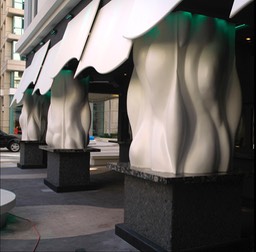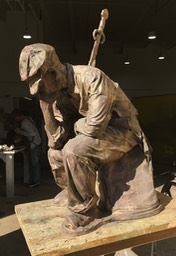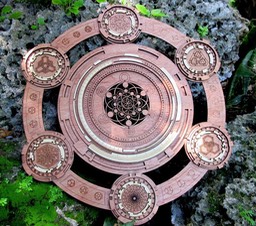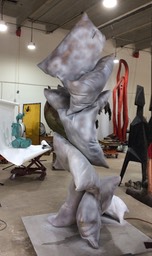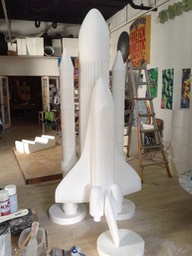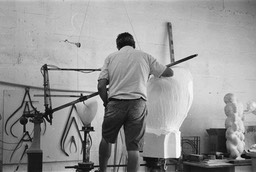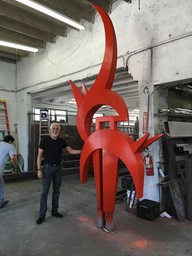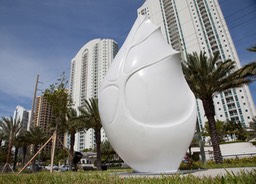Oliver Sanchez has three arms! Besides his own visual arts practice, he operates the multi-purpose Swampspace gallery space and fabricates – primarily sculptural work – for architects, designers and artists.
THE INVISIBLE ARTIST
BY GEORGE FISHMAN
george@QRartguide
The long-armed, antique hinged apparatus that Olivier Haligon proudly shows visitors to his Little Haiti art fabrication studio is a 3D pantograph that his great grandfather built. It’s both a tangible connection to his heritage and a thoroughly practical instrument for enlarging and reducing sculptural forms. “It’s like the ancestor of the 3D printer,” he said.
Haligon and his team at O. Haligon Fine Art are part of the technical backbone used by sculptors and other artists to realize their visions. While fabricators, foundries and maker spaces rarely show up in artist credits, their expertise is often critical. In a land of hurricanes, engineering specifications are vital to assuring that artistic achievements — especially outdoor sculptures — remain safe.
Haligon was born into the business, he says. “My father had a studio in Montparnasse,” in Paris. While family members continue operations in France, Olivier set up shop in Miami in 1998. The clients here are long-term, Olivier said. “It’s more than business, because to make a piece exactly as the artist wants, it’s psychological work, too. You have to understand exactly what’s important in their work.”
In South Florida, a relative handful of experts act as artists’ collaborators, forming plaster and silicone into molds, fiberglass into casts, software into digital processes.
At Haligon, moldmaking is itself an artform. While a silicone mold costs four times as much as a single-use plaster “waste” mold, it can be reused, amortizing the cost with an edition of three or more sculptures. Daughter Caroline, who represents the fifth generation in the business, administers the studio but still pitches in with her hands, specializing in moldmaking.
Fiberglass casting is a specialty. Strong, flexible and lightweight, its surface is amenable to brilliant, durable automotive paint finishes. The studio also fabricates steel, hydrocal plaster and aluminum forms. Bronze casting is outsourced.
Proper plaster mixing is critical to both moldmaking and casting. “If you don’t have the right consistency and it cures too fast, or if it’s not well mixed, you’re going to have lumps, which means you’re going to have defects on the surface,” Caroline explained while showing scores of plaster plaques by political cartoonist/street artist “Kai.” Many were showcased during the recent Miami Art Week.
Finishes are crucial both for appearance and durability, said the Haligons. Restoration comprises about 20 percent of the company business, so they know how to fix what’s been done improperly and how to avoid problems through proper surface preparation, selection and application of primers and paints.
Often, collectors bring in pieces suffering the effects of other studios’ failed repairs. “When they buy a sculpture, it’s a lifetime investment,” says Olivier, who’s also an engineer, “so if their pieces collapse after three or four years, it’s not going to work.”
Artist Valeria Yamamoto’s Sunny Isles Beach commission “Converge” presented major challenges. Salt air induces corrosion; wind-borne grains sandblast surfaces. Haligon’s solution: After enlarging Yamamoto’s plaster maquette into Styrofoam, they made a four-part plaster waste mold, removed the foam, hand-applied a thin, epoxy-sand shell and braced it internally with a fiberglass and welded steel structure before removing the mold.
AIDE TO ART STARS
Oliver Sanchez didn’t set out to be a conduit for other artists’ visions. Raised in Miami, Sanchez moved in 1977 to New York, where he participated in the art and dance-club explosion. Active with his brother in art direction and graphic design, he befriended Keith Haring, Madonna, Jean-Michel Basquiat and assisted in Kenny Scharf’s studio. Scharf enticed him back to Miami in 1992.
Oliver Sanchez - Art Fabricator from Fishman George on Vimeo.
Along with making his own wryly humorous paintings, Sanchez directs Swampspace, an alternative venue for artists, students and visionaries outside the commercial mainstream.
Buttressed by an architecture diploma and adept with clay, wood and other “classic” materials, Sanchez frequently carves or hot-wire-cuts Styrofoam, which he covers with a plaster or epoxy shell and paints. “I like the fact that it’s 98 percent air,” he quipped. A current example is the 10-foot-tall “Space Shuttle,” commissioned by Miami-born artistDaniel Arsham — a frequent client — for a New York retail shop.
“DASH Kids,” standing figures of a boy and girl that tower over the nearby Design and Architecture School campus, is an early, iconic project. Designed in 2001 by Roberto Behar and Rosario Marquardt, (R&R Studios), they’re modeled after Greek philosophers Plato and Aristotle. DASH also provides studio interns, who get real-world experience with Sanchez.
DIGITAL DIY
Artists seeking digital expertise can turn to the Moonlighter prototype fabrication lab in Wynwood, opened a year ago by Florida International University architecture grads Tom Pupo and Daisy Nodal. There, they provide software instruction, sophisticated digital manufacturing resources, networking and workspace to facilitate members’ experimentation with a range of 3D printing, electronics assembly, laser cutting and computer-assisted design (CAD) projects.
“We make it clear that this is an ideas place,” said Pupo. “This is where [artists] test the assumptions and make their final product in a way that can later be manufactured somewhere else.” A variety of membership plans give training in software tools and access to machines that will take the concept of a modular chair, figurative sculpture, micro catheter transporter, skateboard, bio-monitoring maternity dress or fair booth from concept to prototype to short-run production via 3D printers, laser cutters and CNC vinyl cutters. “It’s very hands-on,” explained Pupo. “Electronic modules, sensors, motors … basically your full range of digital manufacturing.”
Jeremy Davis, one of Moonlighter’s first members, has been drawing and painting since he was 8 years old. But he always believed that digital art was cheating. “The computer was doing the art for you, I thought naïvely,” he said.
Introduced to Adobe Illustrator and computer-aided design, he started transforming his pencil drawings into 3D reliefs. “That just changed my whole life right there.” Now he has an Etsy store and sells laminated, laser-engraved plaques that draw inspiration from Tibetan Tonkas, Aztec carvings, Moroccan tiling and digital pattern-generation. “Now we’re creating geometries that haven’t been seen in the world before.”
Whether Davis eventually purchases his own laser cutter or outsources production, he’s on the trajectory the founders envisioned for Moonlighter members.
TEACHER, TOO
Besides mastering metal casting to create her sculpture, Freda Tschumy has established three institutional foundries and taught other artists to realize their projects. Now she is consulting with Wynwood’s Bakehouse Art Complex to incorporate a foundry within its facility upgrades.
An adjacent metal fabrication studio also is in the works. It’s intended to facilitate both resident and community artists to realize ambitious projects, including public art. Designs and some equipment purchases have been made, but full installation and educational programming are probably a year off.
Through decades of teaching, Tschumy has found that an artist capable of creating a life-size portrait in clay, plaster, wax or Styrofoam might realize a finished bronze after eight weeks of three-hour instruction/work sessions at an academic or community foundry.
People are surprised to learn that “after it’s poured, and you break the [mold] away, you have at least 50 percent of the work still to be done,” she said. That includes cutting away air vents, grinding surfaces, welding repairs and applying the chemical finish. If an artist desires to make multiple casts from the original, a more elaborate multi-part moldmaking process is needed, generally using a combination of silicone rubber and plaster.
EXPERIMENTAL ENGINEER
Cuban-born Julio Larraz jokes that “I’m a painter that every once in a while has the illusion of being a sculptor, too.” He recently visited ASU foundry to pick up several pieces for his opening at Ascaso Gallery, timed for Art Week. “You, as an artist, are not working alone. You’re working with them, and they are working with you,” he said of Lazaro Valdes, ASU director. “He has the smarts and the instincts to know what you want, what you are looking to show.”
For scores of artists — both experienced and novice — collaboration with Cuban-born technical director Lazaro and administrator wife Esmerlin has been fruitful and rewarding, and although some artists are not on speaking terms with one another, Esmerlin treats them all like family.
Valdes’ engineering background and experimental attitude as an artist led him through a process of trial and error, beginning with fairly primitive lead casting in Cuba. After arriving in Miami, he began making molds for sculptors Tony Lopez and Guy Garcia, pioneers of Miami’s 1960s arts scene.
For the past 15 years, Valdes has increased his expertise, physical plant, staff (largely family) and equipment. The expansion parallels the demand for casting services — regional and international — that increases each year before Art Week. Dozens of finished “blue chip” pieces and works-in-progress populate the production workshops: moldmaking, wax assembly, ceramic shell investment, pouring, welding, grinding and patina application. His newest acquisitions are a five-axis water jet cutter and six-axis robot.
“From a simple drawing, we’ll be able to produce an original — no matter what size.” Among ASU’s first clients was Antuan Rodriguez, who used the company’s latest-generation equipment a dozen years later to create precision-fabricated works for his current soloexhibition at North Miami’s MOCA.
For artist George Sánchez-Calderón, material and technique are subservient to concept. An interdisciplinary artist, he’s not married to any specific medium or technique. Instead, he seeks an ideal marriage of medium and message, regularly calling on a cadre of neon, glass, wood and metal fabricators. For his 2006–2016 sculpture “After Dürer,” he fashioned a plaster life cast from an indigent neighborhood friend to realize the crowning figure of a memorial tower to a failed peasant uprising, proposed by artist Albrecht Dürer in 1527. The seated figure, which ASU recently cast in bronze, is stabbed in the back by a sword, reflecting the despondency of impoverishment and powerlessness. “It’s a message that resonates 500 years later. Nothing has changed,” Sánchez-Calderón said.
Technical expertise
Many artworks require the skilled hands of artistic fabricators and foundries. Among those favored by South Florida artists:
▪ Aim Con Steel, aimconsteelllc.thebluebook.com
▪ Art & Sculpture Unlimited, asubronze.com
▪ Bakehouse Art Complex artists’ studios, bacfl.org
▪ Monica Leslie Travis workshop, monicaleslietravis.com
▪ Moonlighter, moonlighter.co
▪ O. Haligon Fine Art, haligonfineart.com
▪ Oliver Sanchez, swampspace.blogspot.com
video (bitly.com/OliverSanchezVideo)
▪ More resources: bitly.com/FoundryListings
